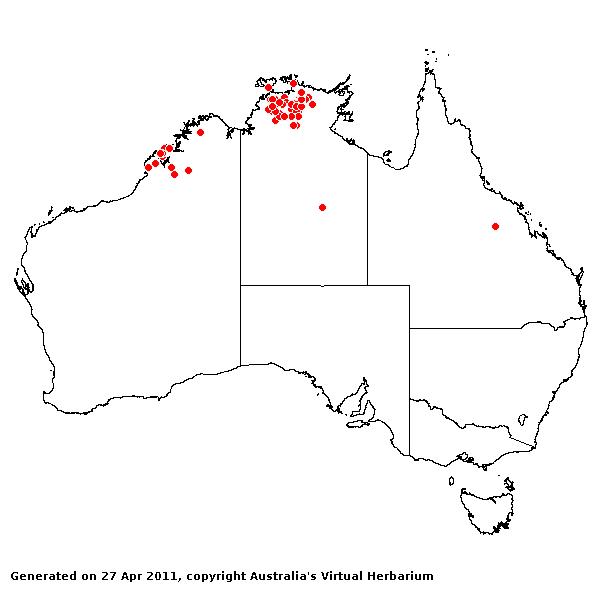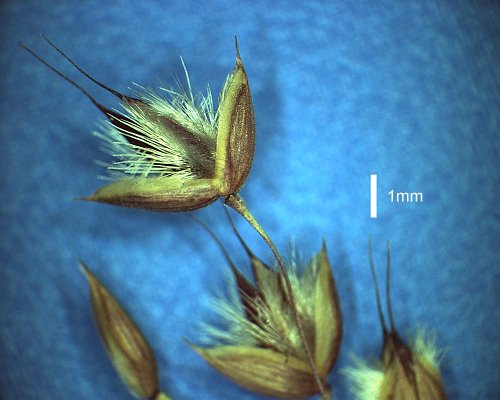Eriachne semiciliata M. Lazarides. Austral. Syst. Bot. 8: 416 (1995).
Classification. (GPWG 2001) : Subfamily Micrairoideae. Eriachneae.
Type of Basionym or
Protologue Information: Australia: Northern Territory: Darwin and Gulf
District: 12.30S 131.70E, M. Lazarides & L.G. Adams 266 (HTCANB; IT:
B, BRI, DNA, E, NSW, P, US).
Key references
(books and floras): [2002] D.Sharp & B.K.Simon, AusGrass, Grasses of
Australia.
Illustrations:
[2005] K.Mallet (ed.), Flora of Australia 44B: Poaceae 3 (Fig.
28C).
Habit. Annual.
Culms geniculately ascending, stature slender to delicate, 20–54 cm tall, 4–6
-noded. Mid-culm internodes hispid. Mid-culm nodes pubescent or bearded.
Lateral branches branched. Leaf-sheaths hairy. Ligule a fringe of hairs,
0.8–1.7 mm long. Leaf-blades flat or involute, 2–4 cm long, 2–3 mm wide.
Leaf-blade surface smooth or scabrous, indumented.
Inflorescence.
Inflorescence compound, a panicle. Panicle oblong, 2–10.5 cm long, 1–1.4 cm
wide.
Spikelets.
Spikelets pedicelled. Fertile spikelets 2-flowered, both fertile, comprising 2
fertile floret(s), without rachilla extension, ovate, laterally compressed,
2.5–4 mm long.
Glumes.
Glumes similar, thinner than fertile lemma. Lower glume elliptic or ovate or
orbicular, membranous, much thinner on margins, without keels, 7–9(–11)
-nerved. Lower glume surface glabrous. Lower glume apex mucronate. Upper glume
elliptic or ovate or orbicular, 2.5–4 mm long, membranous, without keels,
7–9(–11) -nerved. Upper glume surface smooth or asperulous, glabrous or
indumented. Upper glume apex mucronate.
Florets.
Fertile lemma 2.5–3.5 mm long, without keel, 5 -nerved. Lemma surface
indumented. Lemma apex awned, 1 -awned. Median (principal) awn 0.6–4.5 mm long
overall. Palea 2 -nerved. Palea apex entire or dentate. Lodicules present.
Anthers 3. Grain 1.5–2.5 mm long.
Continental
Distribution: Australasia.
Australian
Distribution: Western Australia, Northern Territory.
Western Australia:
Fitzgerald, Dampier. Northern Territory: Darwin & Gulf.
Notes.
Eriachne ciliata is similar in appearance and morphology to E.
semiciliata. However, in E. ciliata the glumes are acuminate (not
obtuse), the florets slightly shorter than the glumes (not longer), and the
lemmas ciliate on the margins for their entire length (not glabrous near the
apex). Also, the dense scaberulous indumentum on the culms and foliage is
predominantly retrorse or retrorsely tipped, in contrast to the chiefly
antrorse condition in E. ciliata.
Endemic.
N of 18ºS in N.T. and W.A. Common in skeletal, often gravelly, soils over
sandstone, laterite, quartzite, conglomerate and shale, on hillslopes, ridges
and rocky plateaux; recorded also from disturbed ground, floodplains, red brown
sandy loams, sand dunes and sandy clay "pindan" plains. Flowers and
fruits chiefly Mar.-Apr. (autumn), but extending Feb.-June (late-summer to
early-winter).




